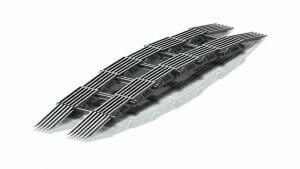“Bridge-in-a-box” design supports 84,000 pounds during testing
SAN DIEGO, Calif., January 12, 2012 — ATA Engineering, Inc. is pleased to announce the successful completion of proof testing of the ARCS™ deployable bridge system. Technologies incorporated in the ARCS bridge result from a three-year effort funded by the US Army’s TARDEC (Tank Automotive Research, Development and Engineering Center). Under an SBIR (Small Business Innovation and Research) grant, ATA developed a highly portable, reconfigurable design that addresses several of the shortcomings of today’s deployable bridging technologies. The prototype that resulted from this effort is a 42-foot, 7,000-pound demonstration bridge constructed from aluminum and designed to handle loads in excess of 30 tons. Unlike other temporary bridging systems that typically require large transport and deployment vehicles and are limited to a fixed span and load capacity, ARCS can be deployed rapidly while remaining adaptable to different gap widths and loads. Fulfilling the need for a “bridge-in-a-box,” a complete deployment-ready 80-foot bridge can be transported to the need site inside a standard intermodal shipping container.
A comprehensive proof-testing and validation program of the prototype system was undertaken in July of 2011 at an ATA facility in Del Mar, CA. Developed to accommodate crossing by a 30 ton vehicle over a 12 meter (40 foot) gap, the bridge was composed of six segments constructed from interleaved aluminum modules. To simulate traversing by a large military vehicle, steel plates were loaded onto the bridge and moved across the span. While the bridge was designed to support loads of up to 60,000 pounds, ATA successfully tested the bridge to 84,000 pounds. In addition to loading with plates, various vehicles including an 11-ton forklift successfully traversed the bridge. Material stresses, bridge displacement, and cable tensions were recorded at numerous locations during testing, and close correlation of the test data and the analytical model predictions showed that the prototype bridge met or exceeded all design objectives.
While the ARCS deployable bridge system is ready to be put to use, future development is expected to demonstrate the system’s capability at spans exceeding 100 feet and for crossing by vehicles in excess of 75 tons. Proposed studies include deployment method refinement for end-users and fabrication of bridge segments using lightweight composite materials. Though the bridge system was designed with the U.S. Army’s needs in mind, the system has a far broader applicability and can provide unique temporary bridging solutions for civilian projects due to its adaptability, logistical benefits, and low environmental impact when deployed.
Disclaimer: Reference herein to any specific commercial company, product, process,or service by trade name, manufacturer, or otherwise, does not necessarily constitute or imply its endorsement, recommendation, or favoring by the United States Government or the Department of the Army (DoA). The opinions of the authors expressed herein do not necessarily state or reflect those of the United States Government or the DoA, and shall not be used for advertisingor product endorsement purposes.As the author(s) is(are) not a Government employee(s), this document was only reviewed for export controls, and improper Army association or emblem usage considerations. All other legal considerations are the responsibility of the author and his/her/their employer(s).
Distribution approved for Public Release; distribution Unlimited, per AR 380-5. OPSEC Review conducted per AR 530-1 and HQ TACOM OPSEC SOP.


